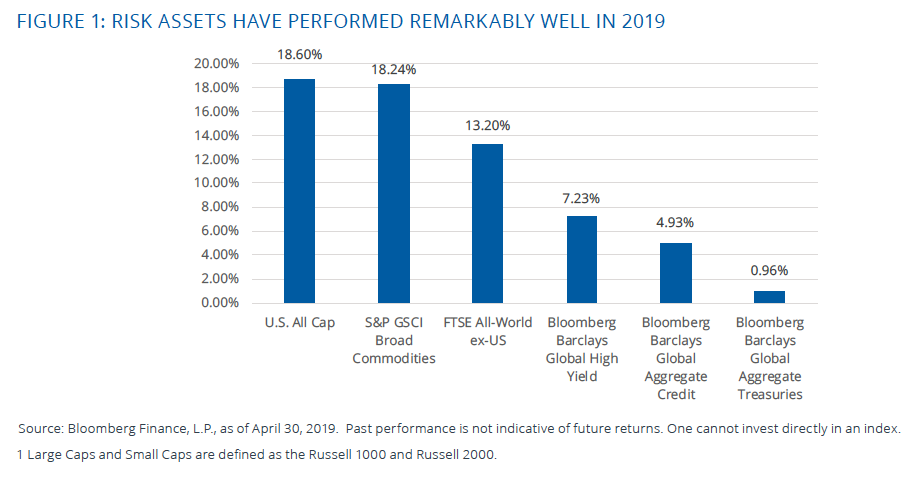Year-to-date performance for U.S. equities have been fueling both large cap and small cap stocks, as both jockeyed for position in April. Thanks to a more accommodating central bank in terms of interest rate policy, the markets have been able to fend off other macro fears like slower global growth.
More help came from the U.S. economy rebounding in the first quarter this year, as it beat analysts’ expectations of 2.5 percent growth with a 3.2 percent growth number. The GDP figure represents the strongest rate of growth for the first quarter in four years and matches the 3.2 percent growth experienced a year ago.
“It has undeniably been quite an extraordinary first four months of the year for broad U.S. markets,” wrote David Mazza, Managing Director and Inkoo Kang, Vice President in Direxion’s latest Relative Weight Spotlight. “The Russell 1000 gained 18.60% (total return) through April, and Small Cap stocks, as measured by the Russell 2000, provided 18.48% through the end of April. To put that into perspective, the last time we saw both Large Caps and Small Caps provide greater than 18% total returns over four months’ time was in December of 2010.
“In terms of seasonality, 2019 provided the strongest January-to-April return for Small Cap stocks since 1991, and the strongest January-to-April return for the Russell 1000 since 1987. As a result, volatility calmed dramatically: the average for the CBOE Volatility Index throughout the first four months of 2019 was 15.56, which was notably lower than the 19.17 average throughout the last four months of 2018.”

Despite their strong start to the year, small cap equities did give up pole position to their larger cap brethren as the year wore on. Fueled by a spate of better-than-expected first quarter earnings, large caps have managed to regain the lead, but not by much.
“While Large Cap and Small Cap stocks show very similar returns through the close of business on April 30, leadership shifted from Small Caps to Large Caps in a noticeable way,” the report noted. “Through the month of January, Small Caps provided almost 3% in outperformance relative to Large Caps. Whether it was driven by a flight to quality, or simply market leadership from Large Cap Technology names, Small Caps gave all of this outperformance back over the trailing three months.”
For investors looking for continued upside in large cap equities over small caps, the Direxion Russell Large Over Small Cap ETF (NYSEArca: RWLS) offers them the ability to benefit not only from large cap equities potentially performing well, but from their outperformance compared to their small cap brethren.
Conversely, if investors believe that small cap equities will outperform large cap equities, the Direxion Russell Small Over Large Cap ETF (NYSEArca: RWSL) provides a means to not only see small cap stocks perform well, but a way to capitalize on their outperformance versus their large cap brethren.
For more relative market trends, visit our Relative Value Channel.

